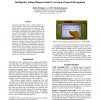2047 search results - page 28 / 410 » The limits of speech recognition |
AAAI
2010
13 years 10 months ago
2010
Correcting recognition errors is often necessary in a speech interface. These errors not only reduce users' overall entry rate, but can also lead to frustration. While making...
ICML
2006
IEEE
14 years 9 months ago
2006
IEEE
Many real-world sequence learning tasks require the prediction of sequences of labels from noisy, unsegmented input data. In speech recognition, for example, an acoustic signal is...
CVPR
2004
IEEE
14 years 10 months ago
2004
IEEE
Speech reading, also known as lip reading, is aimed at extracting visual cues of lip and facial movements to aid in recognition of speech. The main hurdle for speech reading is th...
ESANN
2007
13 years 10 months ago
2007
Inspired by recent findings on the similarities between the primary auditory and visual cortex we propose a neural network for speech recognition based on a hierarchical feedforw...
ICMCS
2008
IEEE
14 years 3 months ago
2008
IEEE
Conventional frequency-domain speech enhancement filters improve signal-to-noise ratio (SNR), but also produce speech distortions. This paper describes a novel post-processing al...

